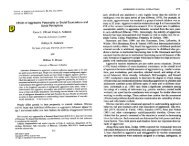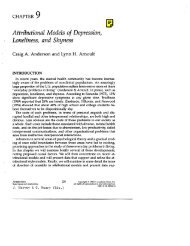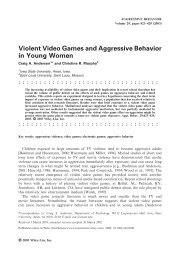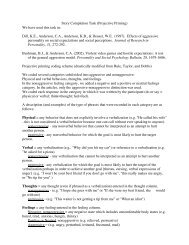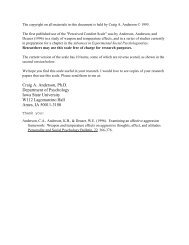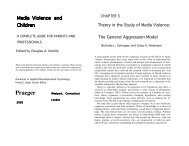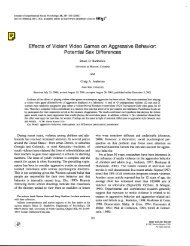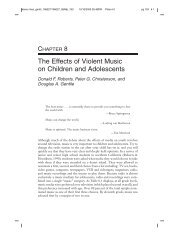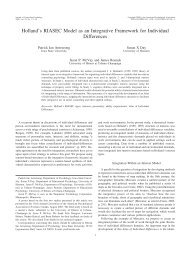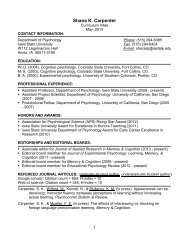The General Aggression Model: Theoretical Extensions to Violence
The General Aggression Model: Theoretical Extensions to Violence
The General Aggression Model: Theoretical Extensions to Violence
You also want an ePaper? Increase the reach of your titles
YUMPU automatically turns print PDFs into web optimized ePapers that Google loves.
250 DEWALL, ANDERSON, AND BUSHMAN<br />
(DeWall & Bushman, 2009). Second, many of<br />
the environmental risk fac<strong>to</strong>rs known <strong>to</strong> increase<br />
the likelihood of a child growing up <strong>to</strong> be<br />
an aggression-prone adult will become more<br />
widespread worldwide, especially in regions<br />
likely <strong>to</strong> experience flooding as a result of sea<br />
level increases, tropical s<strong>to</strong>rms, glacial melt,<br />
and regions likely <strong>to</strong> experience drought and<br />
resulting food and water shortages. Poor preand<br />
postnatal nutrition is known <strong>to</strong> influence a<br />
host of aggression-related competencies and<br />
proneness <strong>to</strong> violence (e.g., DeLisi, 2005; Liu,<br />
Raine, Venables, & Mednick, 2004). Indeed,<br />
recent molecular genetics studies have found<br />
specific brain chemistry-related Genetic � Environment<br />
interactions (both physical and social<br />
environments) on violent criminality (see Anderson<br />
& DeLisi, in press). Third, his<strong>to</strong>rical and<br />
contemporary research shows that rapid climate<br />
change can increase group violence. Specifically,<br />
a growing body of literature supports the<br />
notion that rapid climate change (heating or<br />
cooling) increases civil disorder, political instability,<br />
and war, mostly by creating acute and<br />
recurring resource shortages that lead <strong>to</strong> ecomigration<br />
and violent conflict. Examples include<br />
war in China during 1000–1900 A.D. (Zhang,<br />
Zhang, Lee, & He, 2007), civil war in sub-<br />
Sahara Africa (Burke, Miguel, Satyanath,<br />
Dykema, & Lobell, 2009), ecomigration and<br />
violence in Bangladesh and India, and violence<br />
associated with the U.S. Dust Bowl and Hurricane<br />
Katrina. Similarly, U.S. data reveal a robust<br />
relation between increasingly hot years and<br />
violent crime rates (Anderson, Bushman, &<br />
Groom, 1997; Anderson & DeLisi, in press).<br />
GAM does a better job of explaining the<br />
effects of climate change on violence than other<br />
theories of violence. Whereas socioecological<br />
theories of violence focus primarily on how<br />
people in one’s environment influence violence,<br />
GAM emphasizes the importance of both people<br />
in one’s environment and changes in the<br />
physical environment itself as relevant <strong>to</strong> understanding<br />
violence. Likewise, social learning<br />
theory would explain the relationship between<br />
climate change and violence as a function of<br />
observing a greater number of people behaving<br />
violently, thereby ignoring the importance of<br />
changes in the actual environment (irrespective<br />
of the people in the environment) and their<br />
influence on the higher number of people behaving<br />
violently. Thus, GAM is unique in its<br />
ability <strong>to</strong> account for changes in the environment<br />
that may have implications for increasing<br />
violence, such as increasing ambient temperatures.<br />
Suicide<br />
Why people commit suicide has puzzled social<br />
scientists for centuries. Very few interventions<br />
aimed at reducing suicide are successful<br />
(Van Orden et al., 2010). To prevent suicides,<br />
we need <strong>to</strong> know why they occur. We believe<br />
GAM can offer a powerful framework for understanding<br />
why people commit suicide.<br />
Many of the same person and situation fac<strong>to</strong>rs<br />
that increase aggression between individuals<br />
and groups also increase suicide, sometimes<br />
called self-aggression. Alcohol in<strong>to</strong>xication, for<br />
example, is common among people who die by<br />
suicide (Ohberg, Vuori, & Ojanpera, 1996).<br />
Labora<strong>to</strong>ry research has shown that in<strong>to</strong>xicated<br />
people inflict more intense shocks on themselves<br />
compared with sober people (McCloskey<br />
& Berman, 2003). Feeling rejected and lonely is<br />
also robustly associated with aggression <strong>to</strong>ward<br />
others (e.g., DeWall, Twenge, Bushman, Im, &<br />
Williams, 2010; DeWall, Twenge, Gitter, &<br />
Baumeister, 2009) and with suicide (see Van<br />
Orden et al., 2010, for a review). One longitudinal<br />
study, for example, found that feelings of<br />
loneliness at age 12–13 predicted higher suicidal<br />
risk 30 years later (Rojas & Stenberg,<br />
2010). Just as poor self-control and sero<strong>to</strong>nergic<br />
dysfunction are related <strong>to</strong> aggression against<br />
other people, they are also reliably associated<br />
with an increased risk for death by suicide (e.g.,<br />
Anisman et al., 2008; Brent et al., 1994; Renaud,<br />
Berlim, McGirr, Tousignant, & Turecki,<br />
2008).<br />
Affect, cognition, and arousal all play a crucial<br />
role in suicidal behavior. People who generally<br />
internalize their anger are also more<br />
likely <strong>to</strong> attempt suicide, which is the leading<br />
risk fac<strong>to</strong>r for suicidal completion (see Van<br />
Orden et al., 2010, for a review). Suicidal ideation<br />
refers <strong>to</strong> thoughts related <strong>to</strong> ending one’s<br />
life. <strong>The</strong> more people think about dying by<br />
suicide, the more likely they are <strong>to</strong> die by suicide<br />
(Van Orden, Merrill, & Joiner, 2005). In<br />
addition, diminished arousal <strong>to</strong> the pain and<br />
distress that are associated with suicidal behavior<br />
relate <strong>to</strong> higher numbers of suicide attempts



